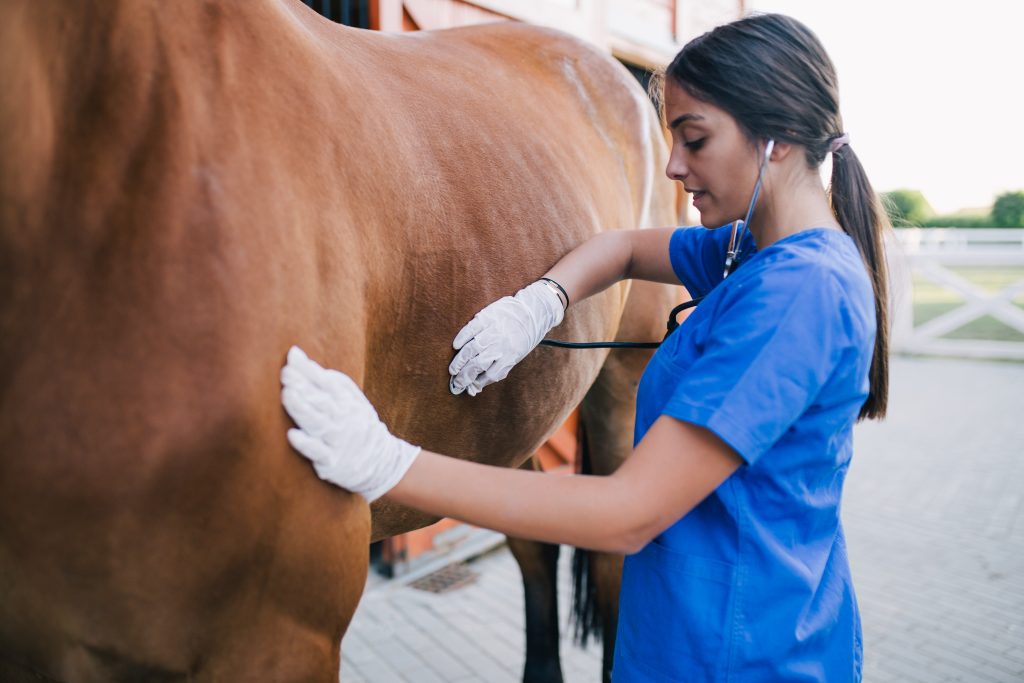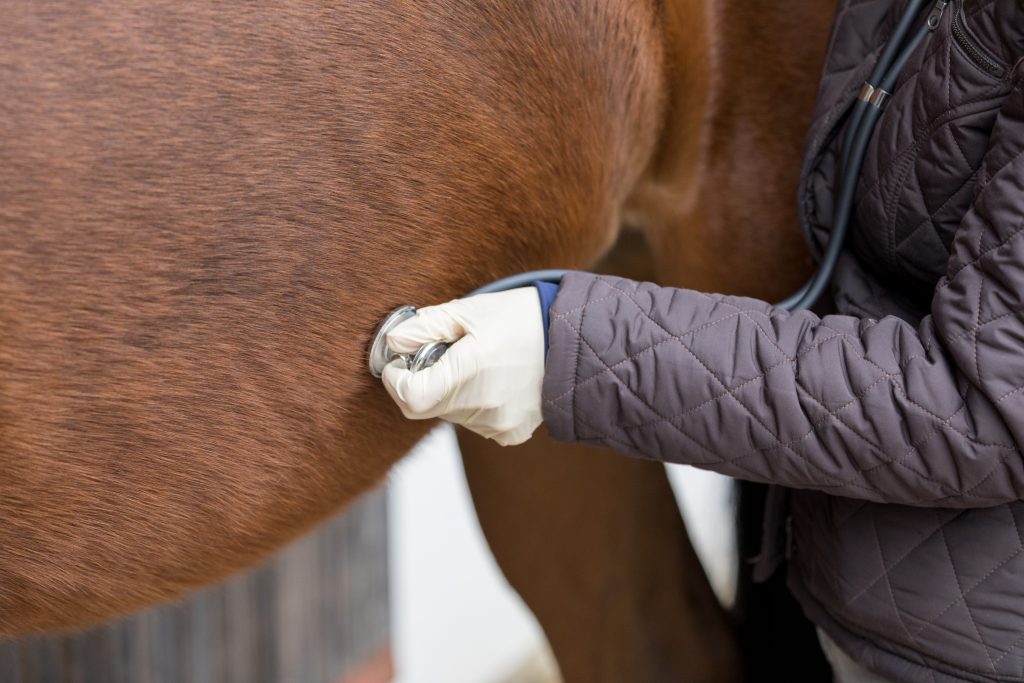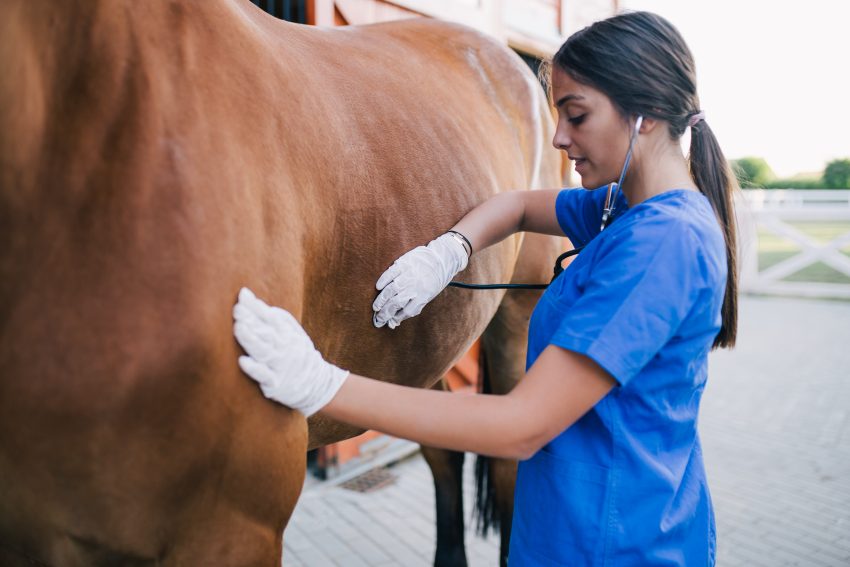
Whether you’re on the road competing week after week or your horse spends most of its time in the pasture, gauging your horse’s level of health is important. Checking your horse’s vital signs regularly allows you to become familiar with what is normal, and you’ll quickly recognize when something is amiss—which will also help you inform your veterinarian if more care is needed.
However, you don’t need a veterinarian on hand to check these vital signs. With a bit of knowledge, you can assess your horse’s basic health in just minutes.
Gather Your Equipment
You don’t necessarily need a fully stocked first aid kit to check your horse’s vital signs. Keeping a few items on hand will make your life easier if something does happen to your horse.
Some suggested equipment includes a digital thermometer, and an inexpensive stethoscope can come in handy for assessing a horse’s heart rate.
Heart Rate
The first step in taking your horse’s vitals is measuring your the heart rate. This should be performed while the horse is at rest, as the heart rate can be falsely elevated due to excitement.
To check your horse’s heart rate, place the stethoscope behind your horse’s left elbow. You can also lightly place your fingers on the facial artery, which is located just before the cheek, to feel for a pulse. A normal resting heart rate is between 28 and 40 beats per minute.
If the heart rate is higher than that range—such as 48 or 50 beats per minute—the horse could be experiencing pain.
Respiratory Rate
Next, assess the respiratory rate. You can do this by watching the horse’s flank. Normally a horse will take eight to 16 breaths per minute, which you can count by watching the abdominal muscles while the horse is breathing in and out. They should not have any flare to the nostrils.
If your horse has a consistently high respiratory rate or greater respiratory effort, it should be assessed by a veterinarian.
Rectal Temperature
You should also take the horse’s temperature rectally. Lubrication is not typically required, unless it is a miniature horse or foal. A horse should typically have a temperature between 99 and 100 degrees Fahrenheit. If the temperature is over 101.5, you should be concerned about a fever.
An increase in temperature could be a sign of an inflammatory response or an infection. If the temperature is persistently elevated or the horse is depressed, veterinary attention is recommended to identify the source of the horse’s fever.
Some horses do not like having their rectal temperature taken, so stand up against the horse’s hind leg—not directly behind the horse—and reach around to take the temperature.

Other Vital Signs
While these three vital measurements are the main sources of information about the horse’s immediate health, there are a few other useful parameters. One is examining the horse’s gums. You can lift the upper lip to look at the mucous membranes. The gums should be a light pink color, and be moist. If they are dry or discolored, your horse could be experiencing dehydration.
Another way to assess hydration is the skin tent test. Pick up a piece of skin on the neck and watch how quickly it snaps back to normal. Under normal circumstances, it should only take the skin a second – two at the most – to return to normal. If it doesn’t, this is another indication of dehydration.
If you’re concerned about your horse’s health, before you call your veterinarian, be prepared for the questions he or she will ask. For instance, if your horse is displaying signs of abdominal pain or colic, it’s a good idea to know the horse’s diet, when it last ate and when it last passed manure. You also want to be aware of your horse’s travel history—if it just returned from a competition, for example. Be ready to report any medications your horse is on and if any other horses in the barn are sick.
Having all this information available in one location helps the veterinarian see the whole picture. The more prepared the owner is, the easier it is for the veterinarian to quickly and effectively treat a horse.
SIDEBAR:
Build a Basic Equine First Aid Kit
When you’re having a medical emergency with your horse, time is critical, and you don’t want to spend a lot of it hunting for necessities. That’s why designating a specific – and stocked – container for first aid is critical, especially for the times it might take a while for the veterinarian to arrive. As a horse owner, you probably have a variety of emergency equipment – from bandages to wound care – already, but it might not all be in the right place. With a kit that you regularly check and update, you’ll know you have what you need when you need it.
Your first aid kit should only have the items you need to tend your horse until the veterinarian arrives. Store any extra products together in another designated area. It would be prudent to also keep a human first-aid kit on hand, and basic ones can easily be found online or even at your local Walmart.
There are plenty of resources and example lists available online. In addition to a rectal thermometer (a plastic digital version is safer than glass and gives faster readings) and a stethoscope, many suggest including a flashlight, gloves, clean towels, duct tape, scissors, tweezers, and a knife. Syringes and needles of various gauges and sizes are also important to have around, as well as Betadine, Nolvasan, and hydrogren peroxide.
Make sure to keep various bandaging materials in your first aid kit so you can stop bleeding quickly. A box of nonstick sterile gauze, VetWrap, a roll of Elastikon, and gauze rolls are a good start.

